Wenjun Wang
InfiR2: A Comprehensive FP8 Training Recipe for Reasoning-Enhanced Language Models
Sep 26, 2025Abstract:The immense computational cost of training Large Language Models (LLMs) presents a major barrier to innovation. While FP8 training offers a promising solution with significant theoretical efficiency gains, its widespread adoption has been hindered by the lack of a comprehensive, open-source training recipe. To bridge this gap, we introduce an end-to-end FP8 training recipe that seamlessly integrates continual pre-training and supervised fine-tuning. Our methodology employs a fine-grained, hybrid-granularity quantization strategy to maintain numerical fidelity while maximizing computational efficiency. Through extensive experiments, including the continue pre-training of models on a 160B-token corpus, we demonstrate that our recipe is not only remarkably stable but also essentially lossless, achieving performance on par with the BF16 baseline across a suite of reasoning benchmarks. Crucially, this is achieved with substantial efficiency improvements, including up to a 22% reduction in training time, a 14% decrease in peak memory usage, and a 19% increase in throughput. Our results establish FP8 as a practical and robust alternative to BF16, and we will release the accompanying code to further democratize large-scale model training.
Addressing Graph Anomaly Detection via Causal Edge Separation and Spectrum
Aug 20, 2025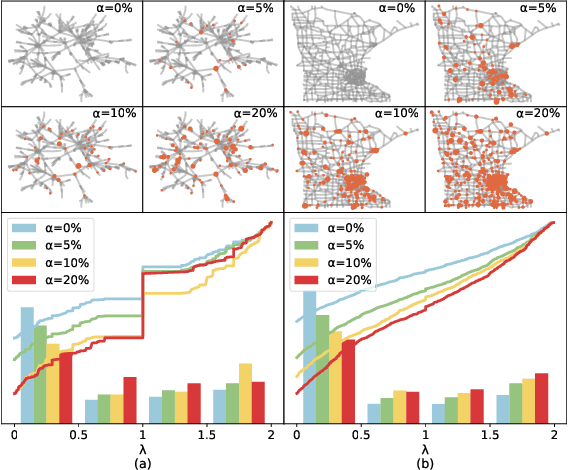
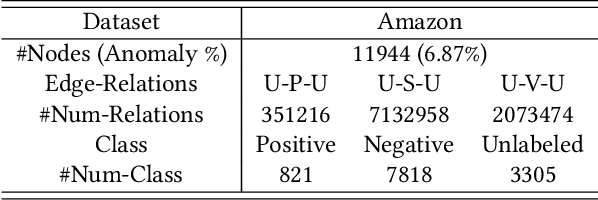
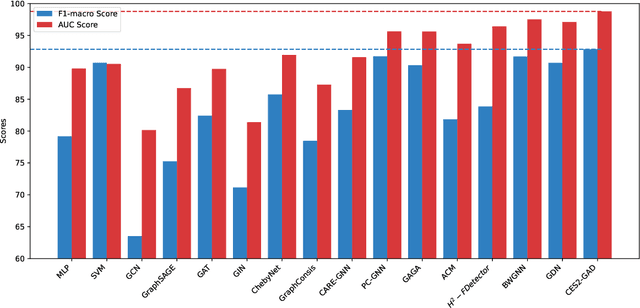
Abstract:In the real world, anomalous entities often add more legitimate connections while hiding direct links with other anomalous entities, leading to heterophilic structures in anomalous networks that most GNN-based techniques fail to address. Several works have been proposed to tackle this issue in the spatial domain. However, these methods overlook the complex relationships between node structure encoding, node features, and their contextual environment and rely on principled guidance, research on solving spectral domain heterophilic problems remains limited. This study analyzes the spectral distribution of nodes with different heterophilic degrees and discovers that the heterophily of anomalous nodes causes the spectral energy to shift from low to high frequencies. To address the above challenges, we propose a spectral neural network CES2-GAD based on causal edge separation for anomaly detection on heterophilic graphs. Firstly, CES2-GAD will separate the original graph into homophilic and heterophilic edges using causal interventions. Subsequently, various hybrid-spectrum filters are used to capture signals from the segmented graphs. Finally, representations from multiple signals are concatenated and input into a classifier to predict anomalies. Extensive experiments with real-world datasets have proven the effectiveness of the method we proposed.
Language Model-Enhanced Message Passing for Heterophilic Graph Learning
May 26, 2025Abstract:Traditional graph neural networks (GNNs), which rely on homophily-driven message passing, struggle with heterophilic graphs where connected nodes exhibit dissimilar features and different labels. While existing methods address heterophily through graph structure refinement or adaptation of neighbor aggregation functions, they often overlook the semantic potential of node text, rely on suboptimal message representation for propagation and compromise performance on homophilic graphs. To address these limitations, we propose a novel language model (LM)-enhanced message passing approach for heterophilic graph leaning (LEMP4HG). Specifically, in the context of text-attributed graph, we provide paired node texts for LM to generate their connection analysis, which are encoded and then fused with paired node textual embeddings through a gating mechanism. The synthesized messages are semantically enriched and adaptively balanced with both nodes' information, which mitigates contradictory signals when neighbor aggregation in heterophilic regions. Furthermore, we introduce an active learning strategy guided by our heuristic MVRD (Modulated Variation of Reliable Distance), selectively enhancing node pairs suffer most from message passing, reducing the cost of analysis generation and side effects on homophilic regions. Extensive experiments validate that our approach excels on heterophilic graphs and performs robustly on homophilic ones, with a graph convolutional network (GCN) backbone and a practical budget.
External Large Foundation Model: How to Efficiently Serve Trillions of Parameters for Online Ads Recommendation
Feb 26, 2025



Abstract:Ads recommendation is a prominent service of online advertising systems and has been actively studied. Recent studies indicate that scaling-up and advanced design of the recommendation model can bring significant performance improvement. However, with a larger model scale, such prior studies have a significantly increasing gap from industry as they often neglect two fundamental challenges in industrial-scale applications. First, training and inference budgets are restricted for the model to be served, exceeding which may incur latency and impair user experience. Second, large-volume data arrive in a streaming mode with data distributions dynamically shifting, as new users/ads join and existing users/ads leave the system. We propose the External Large Foundation Model (ExFM) framework to address the overlooked challenges. Specifically, we develop external distillation and a data augmentation system (DAS) to control the computational cost of training/inference while maintaining high performance. We design the teacher in a way like a foundation model (FM) that can serve multiple students as vertical models (VMs) to amortize its building cost. We propose Auxiliary Head and Student Adapter to mitigate the data distribution gap between FM and VMs caused by the streaming data issue. Comprehensive experiments on internal industrial-scale applications and public datasets demonstrate significant performance gain by ExFM.
InfiR : Crafting Effective Small Language Models and Multimodal Small Language Models in Reasoning
Feb 17, 2025



Abstract:Large Language Models (LLMs) and Multimodal Large Language Models (MLLMs) have made significant advancements in reasoning capabilities. However, they still face challenges such as high computational demands and privacy concerns. This paper focuses on developing efficient Small Language Models (SLMs) and Multimodal Small Language Models (MSLMs) that retain competitive reasoning abilities. We introduce a novel training pipeline that enhances reasoning capabilities and facilitates deployment on edge devices, achieving state-of-the-art performance while minimizing development costs. \InfR~ aims to advance AI systems by improving reasoning, reducing adoption barriers, and addressing privacy concerns through smaller model sizes. Resources are available at https://github. com/Reallm-Labs/InfiR.
Dual-Modal Prototype Joint Learning for Compositional Zero-Shot Learning
Jan 23, 2025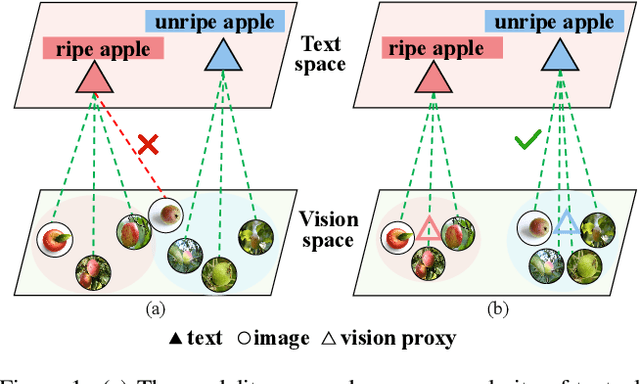

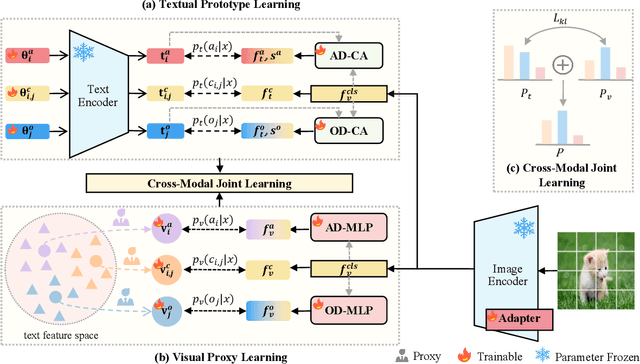
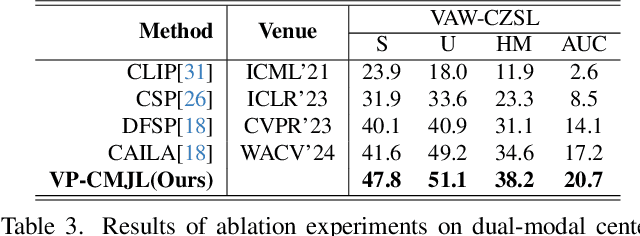
Abstract:Compositional Zero-Shot Learning (CZSL) aims to recognize novel compositions of attributes and objects by leveraging knowledge learned from seen compositions. Recent approaches have explored the use of Vision-Language Models (VLMs) to align textual and visual modalities. These methods typically employ prompt engineering, parameter-tuning, and modality fusion to generate rich textual prototypes that serve as class prototypes for CZSL. However, the modality gap results in textual prototypes being unable to fully capture the optimal representations of all class prototypes, particularly those with fine-grained features, which can be directly obtained from the visual modality. In this paper, we propose a novel Dual-Modal Prototype Joint Learning framework for the CZSL task. Our approach, based on VLMs, introduces prototypes in both the textual and visual modalities. The textual prototype is optimized to capture broad conceptual information, aiding the model's generalization across unseen compositions. Meanwhile, the visual prototype is used to mitigate the classification errors caused by the modality gap and capture fine-grained details to distinguish images with similar appearances. To effectively optimize these prototypes, we design specialized decomposition modules and a joint learning strategy that enrich the features from both modalities. These prototypes not only capture key category information during training but also serve as crucial reference targets during inference. Experimental results demonstrate that our approach achieves state-of-the-art performance in the closed-world setting and competitive performance in the open-world setting across three publicly available CZSL benchmarks. These findings validate the effectiveness of our method in advancing compositional generalization.
MLDGG: Meta-Learning for Domain Generalization on Graphs
Nov 19, 2024

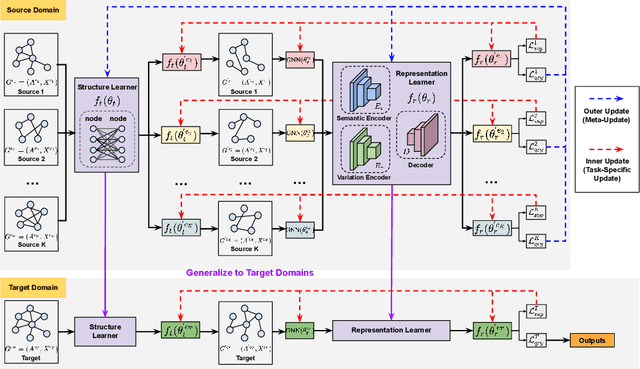
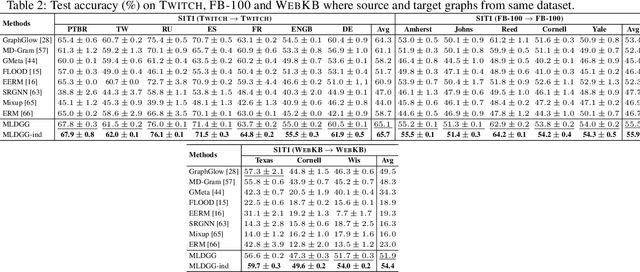
Abstract:Domain generalization on graphs aims to develop models with robust generalization capabilities, ensuring effective performance on the testing set despite disparities between testing and training distributions. However, existing methods often rely on static encoders directly applied to the target domain, constraining its flexible adaptability. In contrast to conventional methodologies, which concentrate on developing specific generalized models, our framework, MLDGG, endeavors to achieve adaptable generalization across diverse domains by integrating cross-multi-domain meta-learning with structure learning and semantic identification. Initially, it introduces a generalized structure learner to mitigate the adverse effects of task-unrelated edges, enhancing the comprehensiveness of representations learned by Graph Neural Networks (GNNs) while capturing shared structural information across domains. Subsequently, a representation learner is designed to disentangle domain-invariant semantic and domain-specific variation information in node embedding by leveraging causal reasoning for semantic identification, further enhancing generalization. In the context of meta-learning, meta-parameters for both learners are optimized to facilitate knowledge transfer and enable effective adaptation to graphs through fine-tuning within the target domains, where target graphs are inaccessible during training. Our empirical results demonstrate that MLDGG surpasses baseline methods, showcasing its effectiveness in three different distribution shift settings.
SEGMN: A Structure-Enhanced Graph Matching Network for Graph Similarity Learning
Nov 06, 2024Abstract:Graph similarity computation (GSC) aims to quantify the similarity score between two graphs. Although recent GSC methods based on graph neural networks (GNNs) take advantage of intra-graph structures in message passing, few of them fully utilize the structures presented by edges to boost the representation of their connected nodes. Moreover, previous cross-graph node embedding matching lacks the perception of the overall structure of the graph pair, due to the fact that the node representations from GNNs are confined to the intra-graph structure, causing the unreasonable similarity score. Intuitively, the cross-graph structure represented in the assignment graph is helpful to rectify the inappropriate matching. Therefore, we propose a structure-enhanced graph matching network (SEGMN). Equipped with a dual embedding learning module and a structure perception matching module, SEGMN achieves structure enhancement in both embedding learning and cross-graph matching. The dual embedding learning module incorporates adjacent edge representation into each node to achieve a structure-enhanced representation. The structure perception matching module achieves cross-graph structure enhancement through assignment graph convolution. The similarity score of each cross-graph node pair can be rectified by aggregating messages from structurally relevant node pairs. Experimental results on benchmark datasets demonstrate that SEGMN outperforms the state-of-the-art GSC methods in the GED regression task, and the structure perception matching module is plug-and-play, which can further improve the performance of the baselines by up to 25%.
Unconstrained Model Merging for Enhanced LLM Reasoning
Oct 17, 2024



Abstract:Recent advancements in building domain-specific large language models (LLMs) have shown remarkable success, especially in tasks requiring reasoning abilities like logical inference over complex relationships and multi-step problem solving. However, creating a powerful all-in-one LLM remains challenging due to the need for proprietary data and vast computational resources. As a resource-friendly alternative, we explore the potential of merging multiple expert models into a single LLM. Existing studies on model merging mainly focus on generalist LLMs instead of domain experts, or the LLMs under the same architecture and size. In this work, we propose an unconstrained model merging framework that accommodates both homogeneous and heterogeneous model architectures with a focus on reasoning tasks. A fine-grained layer-wise weight merging strategy is designed for homogeneous models merging, while heterogeneous model merging is built upon the probabilistic distribution knowledge derived from instruction-response fine-tuning data. Across 7 benchmarks and 9 reasoning-optimized LLMs, we reveal key findings that combinatorial reasoning emerges from merging which surpasses simple additive effects. We propose that unconstrained model merging could serve as a foundation for decentralized LLMs, marking a notable progression from the existing centralized LLM framework. This evolution could enhance wider participation and stimulate additional advancement in the field of artificial intelligence, effectively addressing the constraints posed by centralized models.
Less is More: A Simple yet Effective Token Reduction Method for Efficient Multi-modal LLMs
Sep 17, 2024Abstract:The rapid advancement of Multimodal Large Language Models (MLLMs) has led to remarkable performances across various domains. However, this progress is accompanied by a substantial surge in the resource consumption of these models. We address this pressing issue by introducing a new approach, Token Reduction using CLIP Metric (TRIM), aimed at improving the efficiency of MLLMs without sacrificing their performance. Inspired by human attention patterns in Visual Question Answering (VQA) tasks, TRIM presents a fresh perspective on the selection and reduction of image tokens. The TRIM method has been extensively tested across 12 datasets, and the results demonstrate a significant reduction in computational overhead while maintaining a consistent level of performance. This research marks a critical stride in efficient MLLM development, promoting greater accessibility and sustainability of high-performing models.
 Add to Chrome
Add to Chrome Add to Firefox
Add to Firefox Add to Edge
Add to Edge